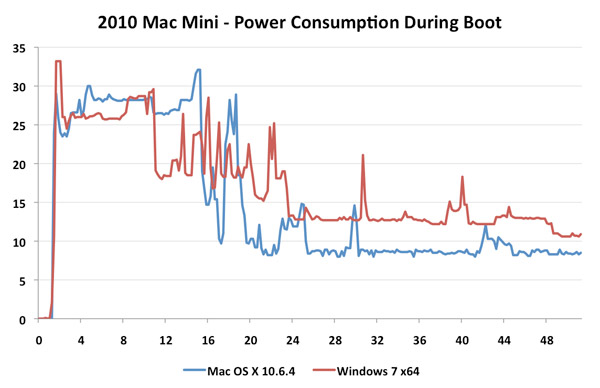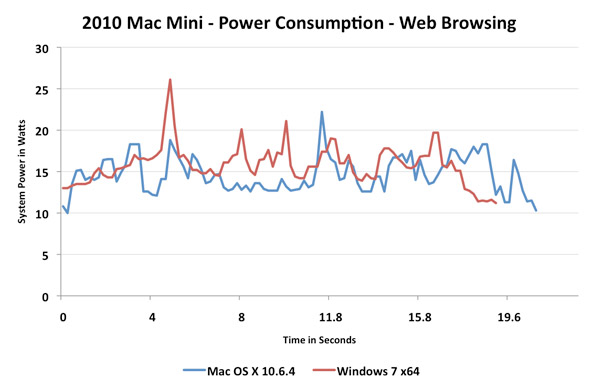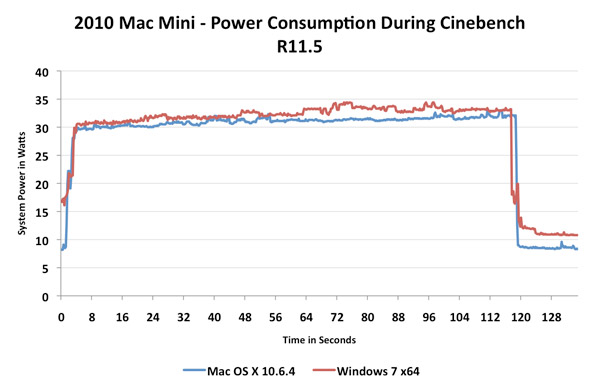Apple Mac mini Review (Mid 2010)
by Anand Lal Shimpi on August 9, 2010 3:37 AM ESTHonest Apple & Energy Efficiency
Apple calls the new Mac mini the world’s most energy-efficient desktop computer. I thought that might be a bit of a stretch but if you look at the numbers, they’re very convincing.
Zotac’s HD-ID11, an Atom based next-generation ION nettop, idles at 21.7W. Even the ASUS UL50V notebook, with a Core 2 Duo SU7300 (1.3GHz) ultra low voltage notebook CPU idles at 8.1W with the screen disabled.
Now that 8.1W number is unrealistic for a notebook. The screen was disabled, battery removed, WiFi disconnected and no ethernet cables plugged in. If I run the 2010 Mac mini in a similar configuration (minus the display/battery part since, well, they don’t exist), the entire system consumes 7.5W at idle.
Connect to a WiFi network, plug in an Ethernet cable and you’re looking at 8W. I have not seen a modern desktop machine idle at lower power than the 2010 Mac mini.
| 2010 Mac mini Power Usage | ||||||||
| Idle | Half Life 2 Episode Two | DVD Playback | Web Browsing | Quicktime Encode | Cinebench R11.5 | |||
| Apple Mac mini (Mid 2010) | 8.0W | 26.4W | 16.1W | 8.6W - 19W | 30.3W | 30.0W | ||
Part of this has to do with Apple’s very efficient integrated PSU. Unlike the other two systems I mentioned here, the mini uses a custom, integrated 85W PSU specifically designed for the system’s load.
Part of it has to do with Apple’s component selection. The mini is built entirely out of notebook parts with a custom motherboard design devoid of anything unnecessary. I’ve even heard that Apple goes to great lengths to ensure the CPUs/GPUs/chipsets it gets are on the lower power portion of the yield curve for products like the mini or MacBook Air.
The third explanation for why Apple is able to make such a bold claim about the Mac mini’s power consumption has nothing to do with hardware at all. As we’ve shown in the past, Mac OS X tends to offer better battery life than Windows in situations where the system sees a lot of idle time. Reading web pages, typing a document, etc... all tend to expose this advantage. Under load however, the OS X power advantage disappears - we are after all dealing with the same components regardless of OS.
The idle battery life advantage comes from lower idle power, presumably through heavy OS and hardware optimization. While I measured 8W at idle under OS X, running Windows 7 (power saver mode) on the Mac mini resulted in a 12W idle power without any changes to the hardware. Granted I don’t have identical hardware by another manufacturer to confirm that this isn’t negligence on Apple’s part to optimize its firmware for Windows 7. However in the past we’ve shown that systems from Lenovo, despite having similar specifications to Apple notebooks deliver worse idle battery life. I believe it’s safe to assume that part of the reason Apple is able to make such a bold claim about the mini’s energy efficiency is because it is the only desktop that can be sold running Mac OS X.
I recorded the mini’s power consumption over time running both OS X 10.6.4 and Windows 7 x64 to give you an idea of where the power consumption differences come into play.
This first chart shows power consumption during the boot process. From power on until you get a cursor at the desktop and the system’s power draw stabilizes for a while. The red line is Windows 7, the blue line is OS X:

Peak power consumption is nearly identical between the two OSes during the boot process. However, OS X drops down to idle sooner (finishes booting quicker) and remains at a lower idle point than Windows 7. Both OSes experience blips of activity after we reach the desktop as additional services are started.
The next test is some basic web browsing using Chrome. I loaded the AnandTech front page, scrolled to an article, clicked on it, scrolled down to the comments and recorded system power consumption:

I tried to get both runs as close as possible to one another, but I am human. Even while browsing the web the CPU has ample time to go into lower power states. Total platform power dips lower under OS X and is lower overall.
Our final test shows a run of Cinebench R11.5. The legend is the same, red for Windows, blue for OS X, but this time the CPU is pegged at 100% for the duration of the test:

The two systems are nearly identical in terms of power consumption. OS X still offers a slight advantage that’s consistent but not pronounced. The render completes in approximately the same amount of time in both OSes, although Windows is a hair quicker. The mini under OS X scored 1.38 points vs. 1.39 under Windows 7.
Since there is a performance difference here, it could just be that Apple is optimizing for power consumption rather than peak performance in the OS itself. It’s difficult to analyze but it’s something I am seeing fairly consistently.










93 Comments
View All Comments
CharonPDX - Monday, August 9, 2010 - link
People talk about how Apple is incapable of switching to the i3/i5/i7 plus a discrete GPU because of size constraints...Yet they forget that the original MacBook Air and the original Mac MIni were both three-chip solutions, with CPU, Intel Northbridge, and Intel Southbridge. If they could fit all three at some time in the past, why can't they fit three now? (CPU, Intel chipset, and nVidia/ATI GPU.)
Especially the mini, whose motherboard has GAINED area. (Not much, since it doesn't fill the whole newly-enlarged chassis, but it did gain a little.)
james.jwb - Monday, August 9, 2010 - link
Aggressive profit requirements per sale at Apple is probably a major reason.Penti - Monday, August 9, 2010 - link
Of course they can, redesigning the boards. But for a discrete mobile gpu too, they also need room for the added memories just like in the MBPs. (Well there's two sides of a PCB). It's a design choice not a limit. They could probably put something like Mobility HD5650 without upping the price and up the ram to 4GB and still make a lot of money. i5-520M 2.4GHz and HM55 costs $265 from Intel, though they also have a much higher power usage. P8600 goes for $209 plus nVidias 320M chipset. The same money + gpu. But it's worse in europe any way since they priced it when the dollar was high, so the mac mini is 809 euros (incl 19% sales tax) that's 900 US dollars before taxes. So we pay over a thousand dollars for something that goes for 699 in the states. For that kind of money 4-8GB, Mobility HD5650, faster drive etc should be standard. It should rather be something like €630. So we pay almost a 30% overprice. On a product that has a 20-30% margin easily.GeorgeH - Monday, August 9, 2010 - link
The current MacBook Air has a bigger battery than the original, so 3 chips (and the extra cooling hardware that would be required for a discrete GPU) wouldn't fit without sacrificing battery life.Penti - Monday, August 9, 2010 - link
Yes it's pretty busy already, http://guide-images.ifixit.net/igi/AaB5PK5d35HGTsZ... & http://guide-images.ifixit.net/igi/KJJyYGCKwbfhmAJ... in the Air. Much more room in the Mac Mini. Enough for discrete graphics I would say, with a serious redesign. Higher density DRAM (x16) might help (some) in the MB Air though.Penti - Monday, August 9, 2010 - link
And the redesigned board (later mid 2009), http://cart-products.ifixit.net/cart-products/ULXA... & http://cart-products.ifixit.net/cart-products/Ti4N... No more room there.Penti - Monday, August 9, 2010 - link
Just to add, mobile discrete GPU will be too much for a 40Wh battery as the macbook Air is using any way.solipsism - Tuesday, August 10, 2010 - link
YOu seem to be forgetting the rounder edges on the case reducing the footprint over a square 7.7”x7.7” footprint, the placement of the components and the PSU which now resides inside the Mini for the first time.Unless it’s using TARDIS technology that MoBo isn’t likely to be big enough.You also have to account for the engineering of larger heat sinks, more or bigger fans and potentially increased power needs. It’s not the simple achievement you are making it out to be.
My guess is that these small machines will get the Core-i when they remove the ODD. They aren’t going to add a $500 9.5mm slot-loading Blu-ray drive and they haven’t added AACS to Mac OS X so you all can stop scratching your head over what should be obvious. They are going to drop ODDs from notebooks and small PCs and move forward from there.
farhadd - Monday, August 9, 2010 - link
You can use any keyboard you like, not just an Apple. F12 functions as the eject key on non-apple keyboards. And you can customize the keys to make the command / option keys whatever you like, not just the windows / alt key that it defaults to.farhadd - Monday, August 9, 2010 - link
Apple still sells white macbooks with 2GB of RAM standard.